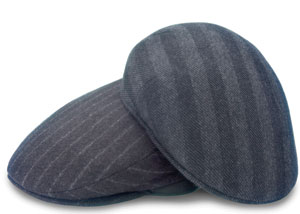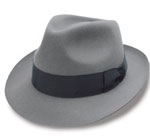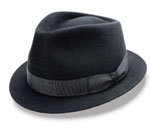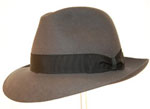|
HATS ARE NO LONGER OFF - THEY'RE ON
Hats are back. After years of going bare-headed, it isn’t just the result of two hard winters that has seen men taking to hats once more, but a swing of the style pendulum that has revived the hat-wearing habit.
At a young level, this began with the awful baseball cap and has gone on to the splendidly excessive fur-trimmed trapper styles and multi-coloured Peruvian tasselled headwear, worn whatever the  temperature this winter in the heart of London. temperature this winter in the heart of London.
More formal are the trilbies, as initially spearheaded by the Madness band, with narrow brims, and also some pork pie styles, à la Sinatra. Moving upwards from the young, casual level, men-about-town are favouring wide-brimmed fedoras and, newer, some natty flat caps in suiting material.
These last come from James Lock, the fabulous hat shop in St James’s, opposite St James’s Palace. This family company has been selling hats to gentlemen since 1676 and what it doesn’t know about hats is not worth knowing.
They didn’t get where they are today by standing still and despite living in this ancient period building, always have a modern take on the latest style requirements. The recent launch of their Lock & Roll collection is evidence of this, reflecting the increase in young custome rs as well as their ability to meet new demands. rs as well as their ability to meet new demands.
The flat caps in this collection come in English suiting and jacketing wool cloths, offering a smart alternative to the standard tweed cap.
“They are proving very popular,” said Andrew Baselgia, manager of the shop. “People in the film and music businesses adopted hats again, followed by other young men, and they have really taken to these caps.”
But top favourite remains the trilby in the shape of the felt Wetherby, while another brimmed felt style, Voyager, has the benefit of not only being particularly light but also may be rolled up, then unrolled at the end of a journey to return to its original shape.
Hats arrive here from all over the world, as do customers. “Our caps are made near Manchester,” said Mr Baselgia, “but others come from all over the globe. There’s the Panama from Ecuador, the Borsalino from Italy, a Stetson from Texas, a big-brimmed outback style from Australia. We go to the specialist makers wherever they may be.”
For those yet to experience the pleasure of choosing and wearing a quality hat, the esoterics and history of the variety, as presented in Lock’s, are fascinating.
Take the Trilby: It was named after the heroine in a George du Maurier novel who wore such a hat in a staged adaptation in 1895.
This relatively modern style followed the earlier top hat, which when first worn in London in 1797 so frightened the natives that it caused a near riot and the wearer was arrested. Reports from the time state that "several women fainted at the unusual sight, while children screamed, dogs yelped and a younger son of Cordwainer Thomas was thrown down by the crowd which collected and had his right arm broken". The wearer, a hatter named John Hetherington, was charged with a breach of the peace and fined £500.
The bowler, once de rigeur for City gents, was initially a riding hat named the Coke, but  became known as the Bowler because that was the name of the makers. The Boater, now replaced as the summer choice by the Panama, was once worn by midshipmen in the Royal Navy, and became part of school uniforms in Victorian England. It was universally adopted as summer wear in Edwardian times, when all men wore hats all the time. became known as the Bowler because that was the name of the makers. The Boater, now replaced as the summer choice by the Panama, was once worn by midshipmen in the Royal Navy, and became part of school uniforms in Victorian England. It was universally adopted as summer wear in Edwardian times, when all men wore hats all the time.
With many new style variations and colours, the fine hatters featured here are all well prepared for such heady days to return.
From the top, suiting caps; the felt Atlantic medium brim; Telstar, from the Lock & Roll collection with extra narrow brim; and Borsalino, Italianate classic.
WHAT'S IN A HAT'S NAME?
The Panama Hat is not a Panama at all. It actually hails from Ecuador.
Responsible for the Panama moniker is an English gentleman of unknown name who was returning from South America by way of the Panama Canal, where he bought a straw hat. On his return to England and being asked where he got his fine hat and not remembering where he bought it, he said ‘Panama’, which stuck.
This is the explanation given by Jean Luc, knowledgeable man ager at men's hatters, Bates, and one-time resident of South America. There are, we have to say, a few other versions of how the Panama got its name but it certainly is not made in Panama, but in Ecuador. ager at men's hatters, Bates, and one-time resident of South America. There are, we have to say, a few other versions of how the Panama got its name but it certainly is not made in Panama, but in Ecuador.
Some time in the mid-1800s, when little old ladies were weaving a variety of straw styles in the streets of Montecristi, some bright sparks began taking them to sell in neighbouring Panama, where there was rather more passing traffic.
Such was the success of this marketing ploy that these hats went on to become internationally successful, with everyone wanting a Panama. The Ecuadorians were stuck with a brand name that is irksome to them but too well established to try to replace. Not many men, after all, are likely to go into a hat shop and ask for an Ecuador.
That many men do ask for a Panama is confirmed by sales at Bates. This venerable institution, based in Jermyn Street, has been selling gentlemen’s hats  for over a hundred years. It is particularly noted for its tweed caps in a wide variety of styles, but also sells lots of straw and felt hats, with a noticeable increase in the last couple of years. for over a hundred years. It is particularly noted for its tweed caps in a wide variety of styles, but also sells lots of straw and felt hats, with a noticeable increase in the last couple of years.
“Yes, more younger men are coming into the shop,” said Jean Luc. “The hat wearing habit is reviving and they are gradually appreciating the difference between a quality fur felt hat, for example, from a traditional hatter and the cheap, mass-produced ones on sale in stores.”
At top, the Planter panama and above, Bates' classic tweed cap with ear muffs.
There are four Panamas to choose from here – the Trilby, Fedora, wide-brimmed Planter and the Rolling version which comes rolled up in its travelling tube, and all are woven by hand in Ecuador. Any one of them may turn a man into a debonaire character, with just a hint of Our Man in Havana about him.
|